2006 TOYOTA RAV4 sensor
[x] Cancel search: sensorPage 1980 of 2000
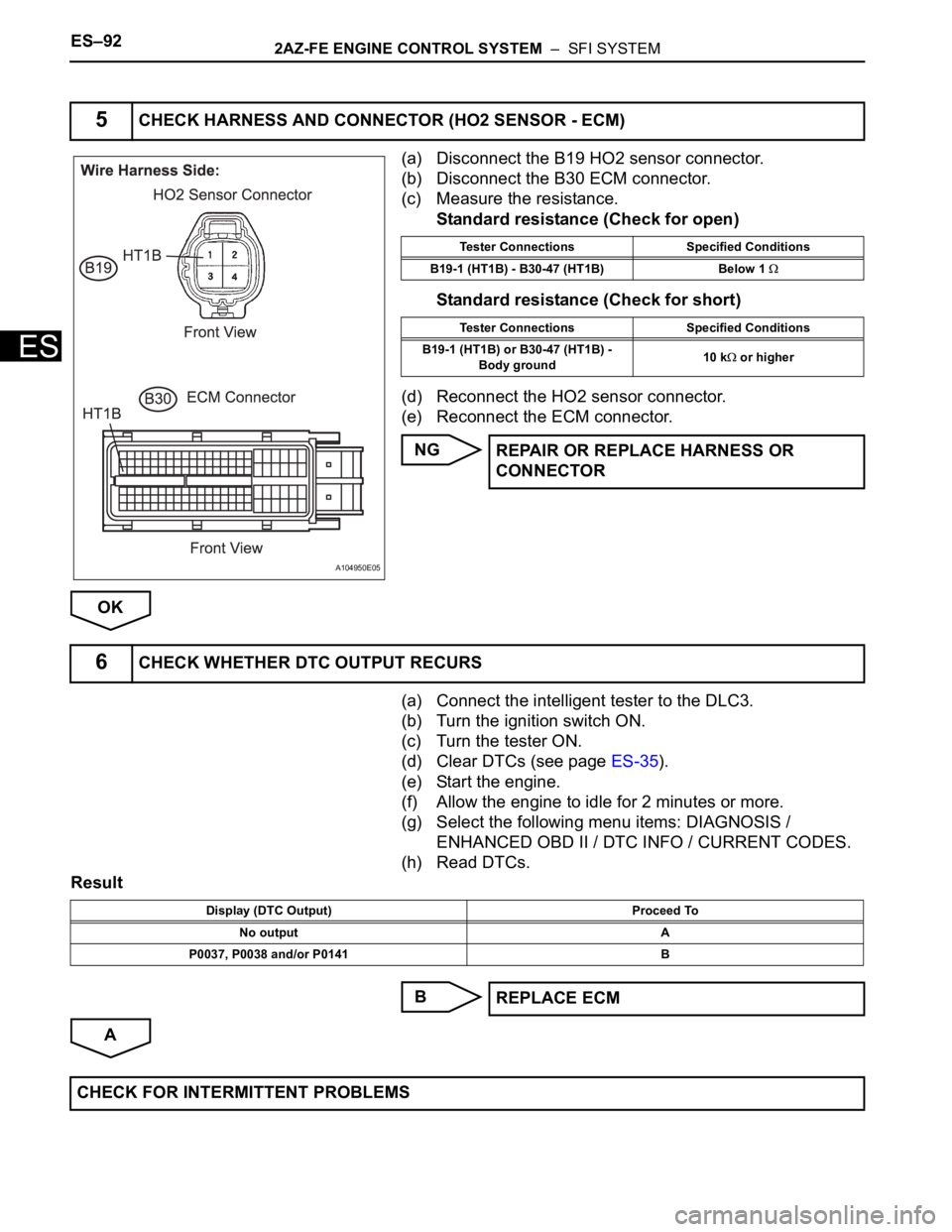
ES–922AZ-FE ENGINE CONTROL SYSTEM – SFI SYSTEM
ES
(a) Disconnect the B19 HO2 sensor connector.
(b) Disconnect the B30 ECM connector.
(c) Measure the resistance.
Standard resistance (Check for open)
Standard resistance (Check for short)
(d) Reconnect the HO2 sensor connector.
(e) Reconnect the ECM connector.
NG
OK
(a) Connect the intelligent tester to the DLC3.
(b) Turn the ignition switch ON.
(c) Turn the tester ON.
(d) Clear DTCs (see page ES-35).
(e) Start the engine.
(f) Allow the engine to idle for 2 minutes or more.
(g) Select the following menu items: DIAGNOSIS /
ENHANCED OBD II / DTC INFO / CURRENT CODES.
(h) Read DTCs.
Result
B
A
5CHECK HARNESS AND CONNECTOR (HO2 SENSOR - ECM)
A104950E05
Tester Connections Specified Conditions
B19-1 (HT1B) - B30-47 (HT1B) Below 1
Tester Connections Specified Conditions
B19-1 (HT1B) or B30-47 (HT1B) -
Body ground10 k
or higher
REPAIR OR REPLACE HARNESS OR
CONNECTOR
6CHECK WHETHER DTC OUTPUT RECURS
Display (DTC Output) Proceed To
No output A
P0037, P0038 and/or P0141 B
REPLACE ECM
CHECK FOR INTERMITTENT PROBLEMS
Page 1981 of 2000
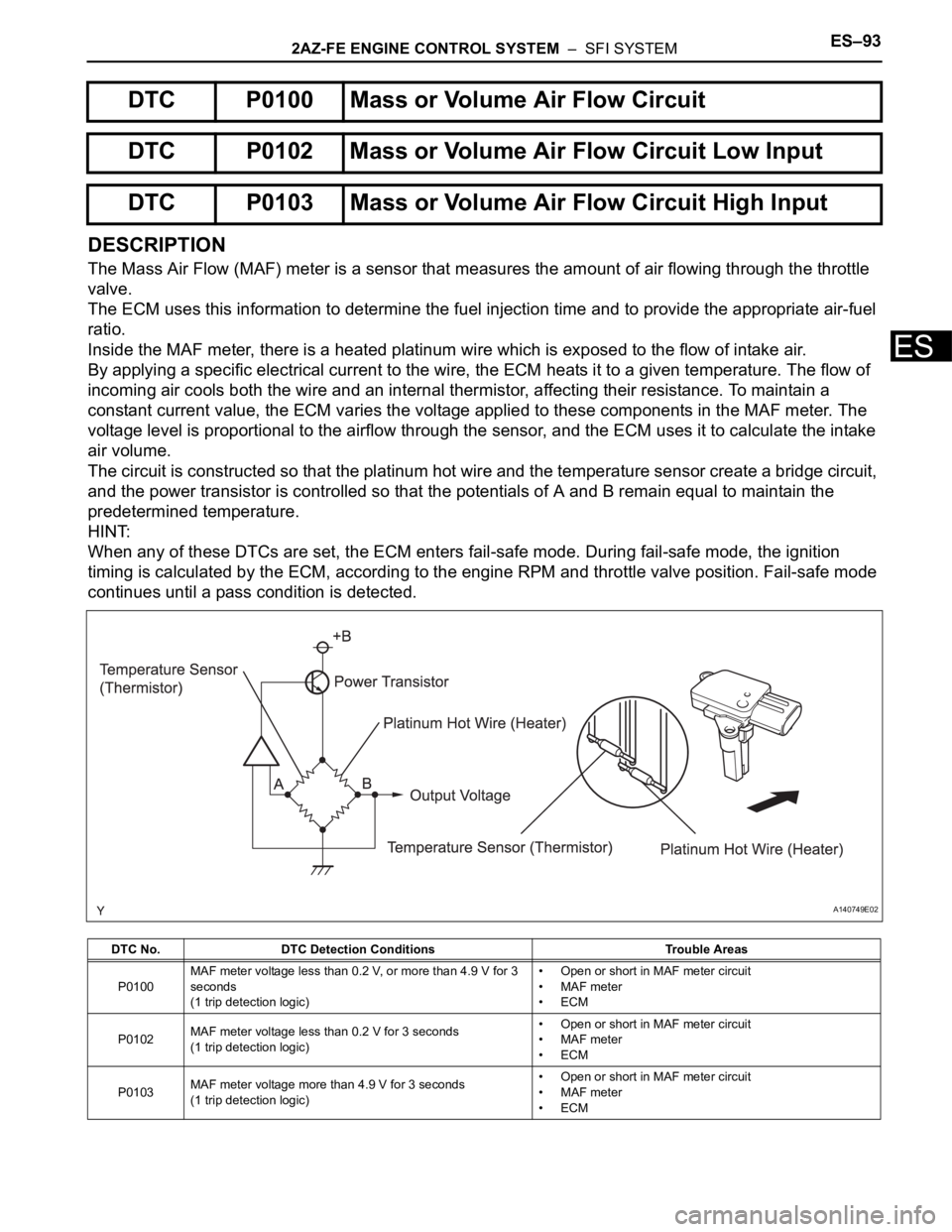
2AZ-FE ENGINE CONTROL SYSTEM – SFI SYSTEMES–93
ES
DESCRIPTION
The Mass Air Flow (MAF) meter is a sensor that measures the amount of air flowing through the throttle
valve.
The ECM uses this information to determine the fuel injection time and to provide the appropriate air-fuel
ratio.
Inside the MAF meter, there is a heated platinum wire which is exposed to the flow of intake air.
By applying a specific electrical current to the wire, the ECM heats it to a given temperature. The flow of
incoming air cools both the wire and an internal thermistor, affecting their resistance. To maintain a
constant current value, the ECM varies the voltage applied to these components in the MAF meter. The
voltage level is proportional to the airflow through the sensor, and the ECM uses it to calculate the intake
air volume.
The circuit is constructed so that the platinum hot wire and the temperature sensor create a bridge circuit,
and the power transistor is controlled so that the potentials of A and B remain equal to maintain the
predetermined temperature.
HINT:
When any of these DTCs are set, the ECM enters fail-safe mode. During fail-safe mode, the ignition
timing is calculated by the ECM, according to the engine RPM and throttle valve position. Fail-safe mode
continues until a pass condition is detected.
DTC P0100 Mass or Volume Air Flow Circuit
DTC P0102 Mass or Volume Air Flow Circuit Low Input
DTC P0103 Mass or Volume Air Flow Circuit High Input
DTC No. DTC Detection Conditions Trouble Areas
P0100MAF meter voltage less than 0.2 V, or more than 4.9 V for 3
seconds
(1 trip detection logic)• Open or short in MAF meter circuit
• MAF meter
•ECM
P0102MAF meter voltage less than 0.2 V for 3 seconds
(1 trip detection logic)• Open or short in MAF meter circuit
• MAF meter
•ECM
P0103MAF meter voltage more than 4.9 V for 3 seconds
(1 trip detection logic)• Open or short in MAF meter circuit
• MAF meter
•ECM
A140749E02
Page 1982 of 2000

ES–942AZ-FE ENGINE CONTROL SYSTEM – SFI SYSTEM
ES
HINT:
When any of these DTCs are set, check the air-flow rate by selecting the following menu items on the
intelligent tester: DIAGNOSIS / ENHANCED OBD II/ DATA LIST / PRIMARY / MAF.
MONITOR DESCRIPTION
If there is a defect in the MAF meter or an open or short circuit, the voltage level deviates from the normal
operating range. The ECM interprets this deviation as a malfunction in the MAF meter and sets a DTC.
Example:
When the sensor output voltage remains less than 0.2 V, or more than 4.9 V, for more than 3 seconds, the
ECM sets a DTC.
If the malfunction is not repaired successfully, a DTC is set 3 seconds after the engine is next started.
MONITOR STRATEGY
TYPICAL ENABLING CONDITIONS
TYPICAL MALFUNCTION THRESHOLDS
P0100:
P0102:
P0103:
COMPONENT OPERATING RANGE
Mass Air Flow Rate (g/sec.) Malfunctions
Approximately 0.0• Open in Mass Air Flow (MAF) meter power source circuit
• Open or short in VG circuit
271.0 or more • Open in E2G circuit
Related DTCsP0100: MAF meter range check (Fluctuating)
P0102: MAF meter range check (Low voltage)
P0103: MAF meter range check (High voltage)
Required Sensors/Components (Main) MAF meter
Required Sensors/Components (Related) Crankshaft position sensor
Frequency of Operation Continuous
Duration 3 seconds
MIL OperationImmediate: Engine RPM less than 4,000 rpm
2 driving cycles: Engine RPM 4,000 rpm or more
Sequence of Operation None
Monitor runs whenever following DTCs not present None
MAF meter voltage Less than 0.2 V, or more than 4.9 V
MAF meter voltage Less than 0.2 V
MAF meter voltage More than 4.9 V
MAF meter voltage Between 0.4 V and 2.2 V
Page 1987 of 2000
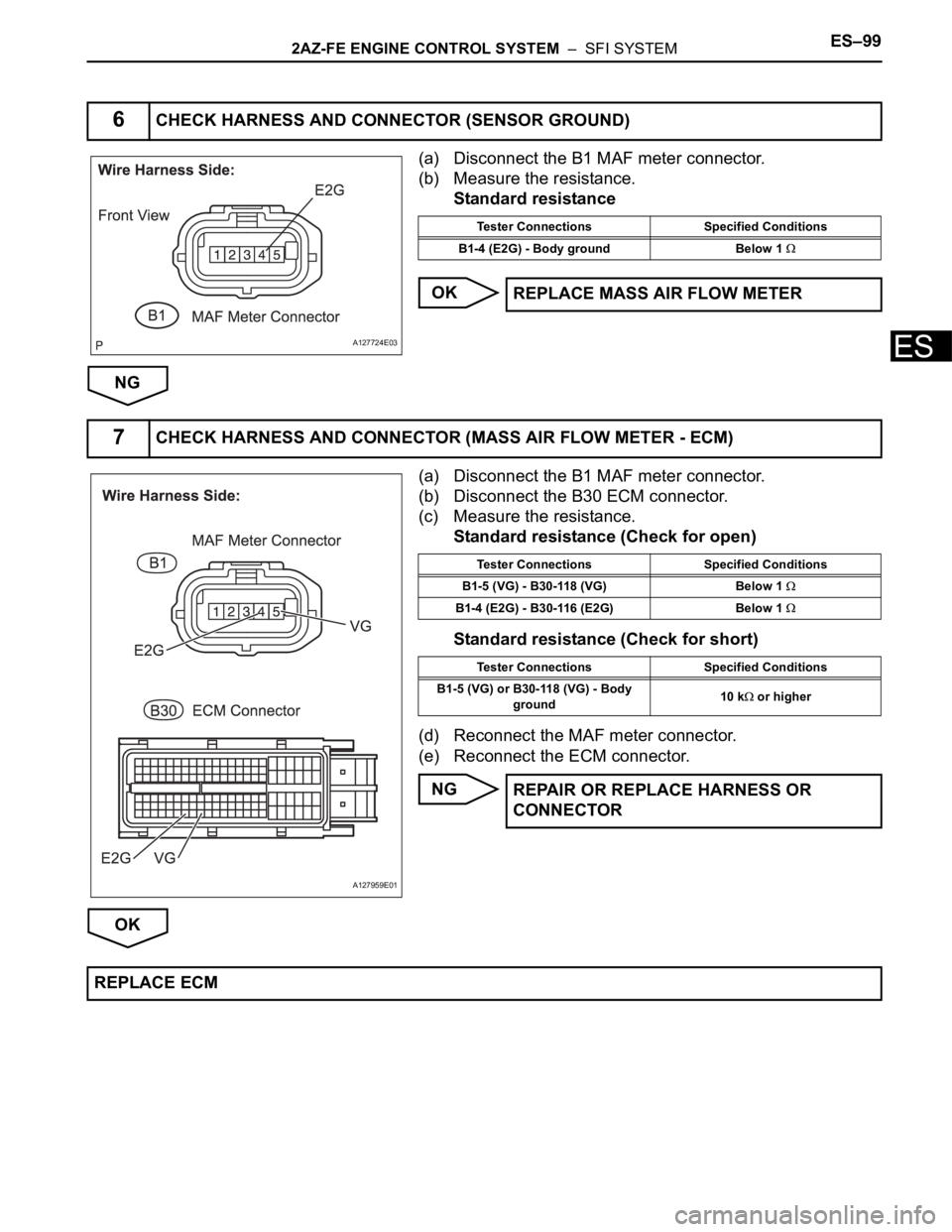
2AZ-FE ENGINE CONTROL SYSTEM – SFI SYSTEMES–99
ES
(a) Disconnect the B1 MAF meter connector.
(b) Measure the resistance.
Standard resistance
OK
NG
(a) Disconnect the B1 MAF meter connector.
(b) Disconnect the B30 ECM connector.
(c) Measure the resistance.
Standard resistance (Check for open)
Standard resistance (Check for short)
(d) Reconnect the MAF meter connector.
(e) Reconnect the ECM connector.
NG
OK
6CHECK HARNESS AND CONNECTOR (SENSOR GROUND)
A127724E03
Tester Connections Specified Conditions
B1-4 (E2G) - Body ground Below 1
REPLACE MASS AIR FLOW METER
7CHECK HARNESS AND CONNECTOR (MASS AIR FLOW METER - ECM)
A127959E01
Tester Connections Specified Conditions
B1-5 (VG) - B30-118 (VG) Below 1
B1-4 (E2G) - B30-116 (E2G) Below 1
Tester Connections Specified Conditions
B1-5 (VG) or B30-118 (VG) - Body
ground10 k
or higher
REPAIR OR REPLACE HARNESS OR
CONNECTOR
REPLACE ECM
Page 1988 of 2000

ES–1002AZ-FE ENGINE CONTROL SYSTEM – SFI SYSTEM
ES
DESCRIPTION
Refer to DTC P0100 (see page ES-86).
MONITOR DESCRIPTION
The MAF meter is a sensor that measures the amount of air flowing through the throttle valve. The ECM
uses this information to determine the fuel injection time and to provide an appropriate air-fuel ratio. Inside
the MAF meter, there is a heated platinum wire which is exposed to the flow of intake air. By applying a
specific electrical current to the wire, the ECM heats it to a specific temperature. The flow of incoming air
cools both the wire and an internal thermistor, affecting their resistance. To maintain a constant current
value, the ECM varies the voltage applied to these components of the MAF meter. The voltage level is
proportional to the airflow through the sensor, and the ECM uses it to calculate the intake air volume.
The ECM monitors the average engine load value ratio to check the MAF meter for malfunctions. The
average engine load value ratio is obtained by comparing the average engine load calculated from the
MAF meter output to the average engine load estimated from the driving conditions, such as the engine
speed and the throttle opening angle. If the average engine load value ratio is below the threshold value,
the ECM determines that the intake air volume is low, and if the average engine load value ratio is above
the threshold value, the ECM determines that the intake air volume is high.
If this is detected in 2 consecutive driving cycles, the MIL is illuminated and a DTC is set.
MONITOR STRATEGY
TYPICAL ENABLING CONDITIONS
DTC P0101Mass Air Flow Circuit Range / Performance
Problem
DTC No. DTC Detection Conditions Trouble Areas
P0101Conditions (a), (b), (c), (d) and (e) continue for more than 10
seconds (2 trip detection logic):
(a) Engine running
(b) Engine coolant temperature 70
C (158F) or higher
(c) Throttle Position (TP) sensor voltage 0.24 V or more
(d) Average engine load value ratio less than 0.85, or more
than 1.15 (varies with estimated engine load)
Average engine load value ratio = Average engine load based
on MAF meter output / Average engine load estimated from
driving conditions
(e) Average air-fuel ratio less than -20 %, or more than 20 %• Mass Air Flow (MAF) meter
• Air induction system
• PCV hose connections
Related DTCs P0101: Mass air flow meter rationality
Required Sensors/Components (Main) Mass air flow meter
Required Sensors/Components (Related)Crankshaft Position (CKP) sensor, Engine Coolant Temperature
(ECT) sensor and Throttle Position (TP) sensor
Frequency of Operation Continuous
Duration 10 seconds
MIL Operation 2 driving cycles
Sequence of Operation None
Monitor runs whenever following DTCs not presentP0115 - P0118 (ECT sensor)
P0120 - P0223, P2135 (TP sensor)
P0125 (Insufficient ECT for closed loop)
P0335 (CKP sensor)
P0340 (CMP sensor)
Throttle position (TP sensor voltage) 0.24 V or more
Engine Running
Battery voltage 10.5 V or more
Page 1989 of 2000
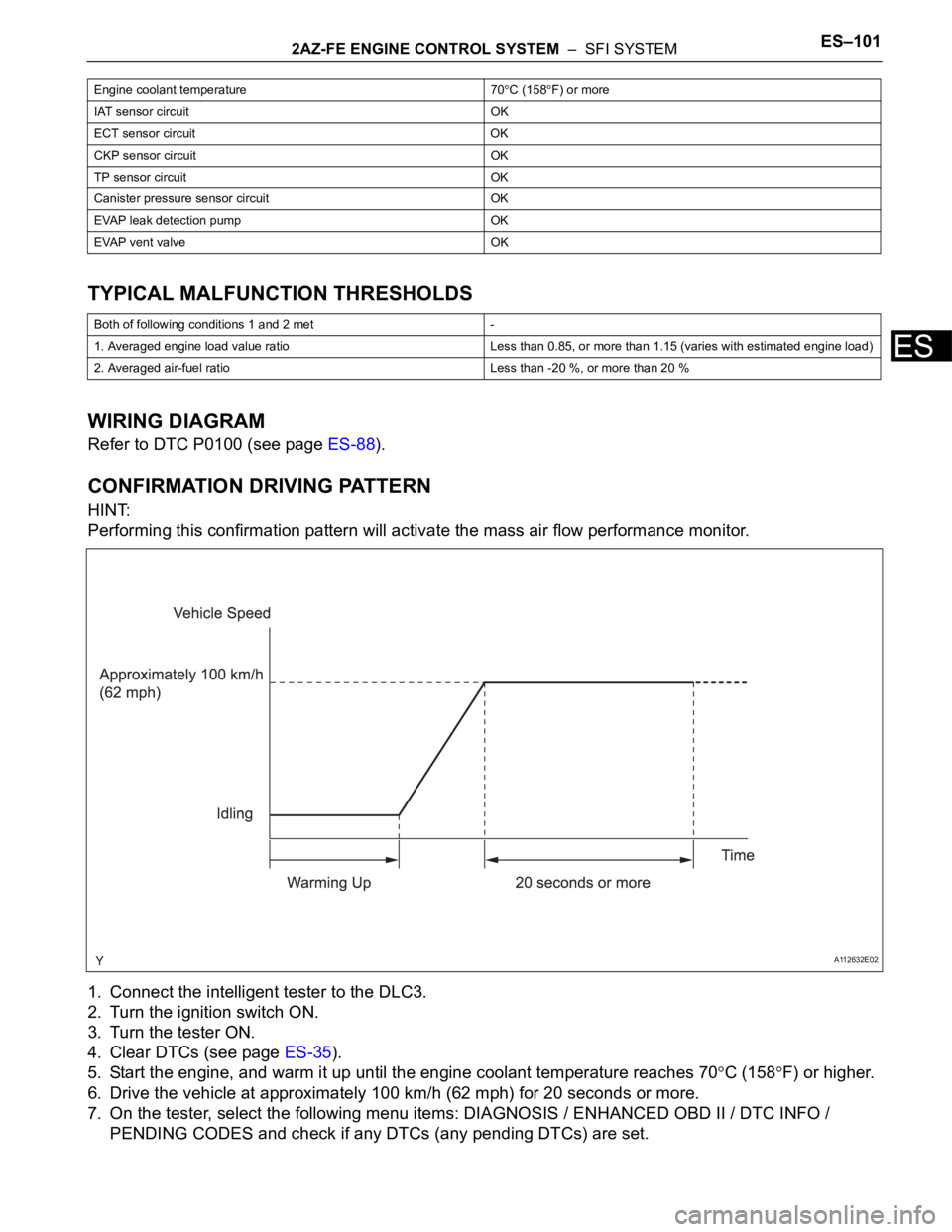
2AZ-FE ENGINE CONTROL SYSTEM – SFI SYSTEMES–101
ES
TYPICAL MALFUNCTION THRESHOLDS
WIRING DIAGRAM
Refer to DTC P0100 (see page ES-88).
CONFIRMATION DRIVING PATTERN
HINT:
Performing this confirmation pattern will activate the mass air flow performance monitor.
1. Connect the intelligent tester to the DLC3.
2. Turn the ignition switch ON.
3. Turn the tester ON.
4. Clear DTCs (see page ES-35).
5. Start the engine, and warm it up until the engine coolant temperature reaches 70
C (158F) or higher.
6. Drive the vehicle at approximately 100 km/h (62 mph) for 20 seconds or more.
7. On the tester, select the following menu items: DIAGNOSIS / ENHANCED OBD II / DTC INFO /
PENDING CODES and check if any DTCs (any pending DTCs) are set.
Engine coolant temperature 70C (158F) or more
IAT sensor circuit OK
ECT sensor circuit OK
CKP sensor circuit OK
TP sensor circuit OK
Canister pressure sensor circuit OK
EVAP leak detection pump OK
EVAP vent valve OK
Both of following conditions 1 and 2 met -
1. Averaged engine load value ratio Less than 0.85, or more than 1.15 (varies with estimated engine load)
2. Averaged air-fuel ratio Less than -20 %, or more than 20 %
A112632E02
Page 1991 of 2000
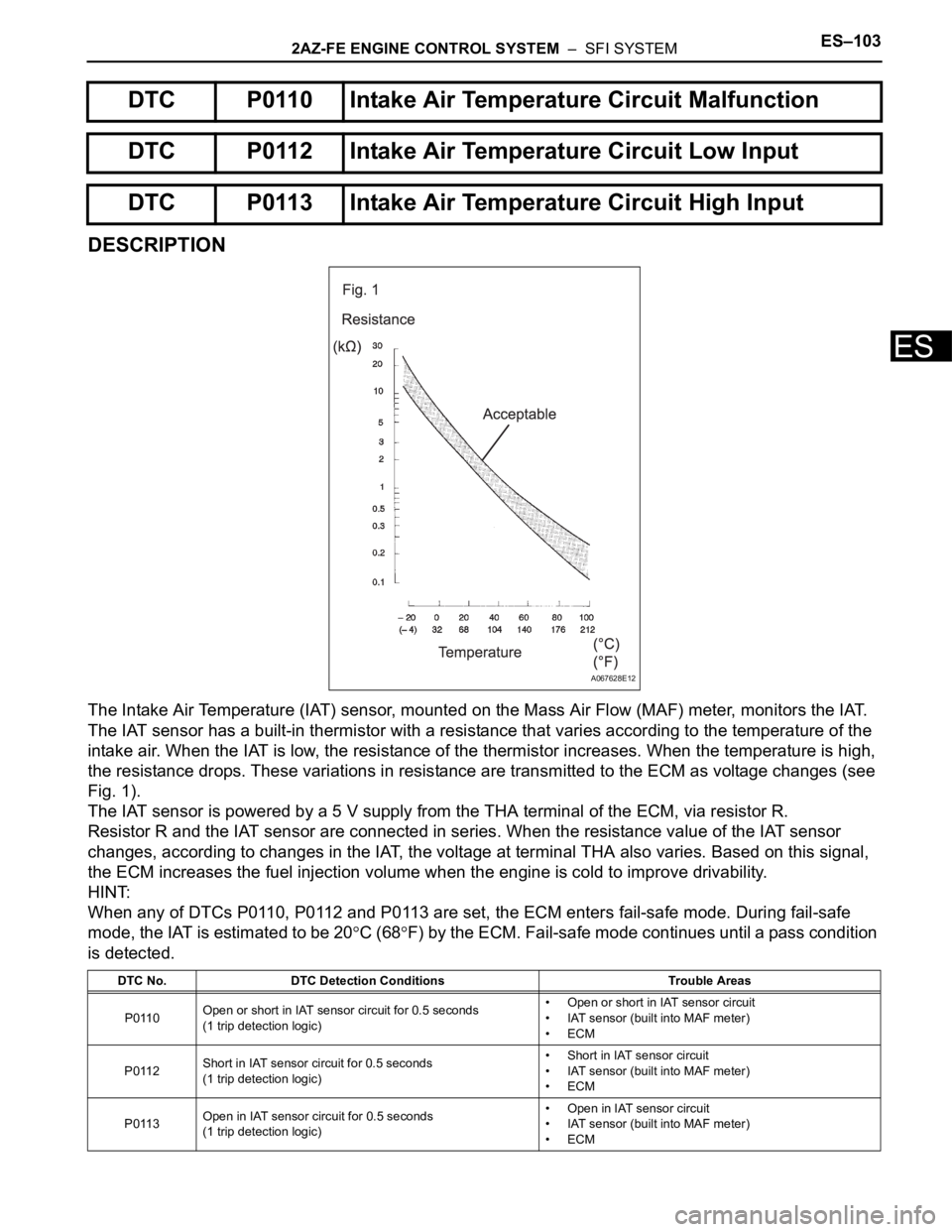
2AZ-FE ENGINE CONTROL SYSTEM – SFI SYSTEMES–103
ES
DESCRIPTION
The Intake Air Temperature (IAT) sensor, mounted on the Mass Air Flow (MAF) meter, monitors the IAT.
The IAT sensor has a built-in thermistor with a resistance that varies according to the temperature of the
intake air. When the IAT is low, the resistance of the thermistor increases. When the temperature is high,
the resistance drops. These variations in resistance are transmitted to the ECM as voltage changes (see
Fig. 1).
The IAT sensor is powered by a 5 V supply from the THA terminal of the ECM, via resistor R.
Resistor R and the IAT sensor are connected in series. When the resistance value of the IAT sensor
changes, according to changes in the IAT, the voltage at terminal THA also varies. Based on this signal,
the ECM increases the fuel injection volume when the engine is cold to improve drivability.
HINT:
When any of DTCs P0110, P0112 and P0113 are set, the ECM enters fail-safe mode. During fail-safe
mode, the IAT is estimated to be 20
C (68F) by the ECM. Fail-safe mode continues until a pass condition
is detected.
DTC P0110 Intake Air Temperature Circuit Malfunction
DTC P0112 Intake Air Temperature Circuit Low Input
DTC P0113 Intake Air Temperature Circuit High Input
DTC No. DTC Detection Conditions Trouble Areas
P0110Open or short in IAT sensor circuit for 0.5 seconds
(1 trip detection logic)• Open or short in IAT sensor circuit
• IAT sensor (built into MAF meter)
•ECM
P0112Short in IAT sensor circuit for 0.5 seconds
(1 trip detection logic)• Short in IAT sensor circuit
• IAT sensor (built into MAF meter)
•ECM
P0113Open in IAT sensor circuit for 0.5 seconds
(1 trip detection logic)• Open in IAT sensor circuit
• IAT sensor (built into MAF meter)
•ECM
A067628E12
Page 1992 of 2000

ES–1042AZ-FE ENGINE CONTROL SYSTEM – SFI SYSTEM
ES
HINT:
When any of these DTCs are set, check the IAT by selecting the following menu items on the intelligent
tester: DIAGNOSIS / ENHANCED OBD II / DATA LIST / PRIMARY / INTAKE AIR.
MONITOR DESCRIPTION
The ECM monitors the sensor voltage and uses this value to calculate the IAT. When the sensor output
voltage deviates from the normal operating range, the ECM interprets this as a malfunction in the IAT
sensor and sets a DTC.
Example:
If the sensor output voltage is more than 4.91 V for 0.5 seconds or more, the ECM determines that there
is an open in the IAT sensor circuit, and sets DTC P0113. Conversely, if the output voltage is less than
0.18 V for 0.5 seconds or more, the ECM determines that there is a short in the sensor circuit, and sets
DTC P0112.
If the malfunction is not repaired successfully, a DTC is set 0.5 seconds after the engine is next started.
MONITOR STRATEGY
TYPICAL ENABLING CONDITIONS
TYPICAL MALFUNCTION THRESHOLDS
P0110:
P0112:
P0113:
COMPONENT OPERATING RANGE
Temperature Displayed Malfunctions
-40
C (-40F) Open circuit
140
C (284F) or higher Short circuit
Related DTCsP0110: IAT sensor range check (Fluctuating)
P0112: IAT sensor range check (Low voltage)
P0113: IAT sensor range check (High voltage)
Required Sensors/Components (Main) IAT sensor
Required Sensors/Components (Related) -
Frequency of Operation Continuous
Duration 0.5 seconds
MIL Operation Immediate
Sequence of Operation None
Monitor runs whenever following DTCs not present None
IAT sensor voltage Less than 0.18 V, or more than 4.91 V
IAT sensor voltage [IAT] Less than 0.18 V [More than 140
C (284F)]
IAT sensor voltage [IAT] More than 4.91 V [Less than -40
C (-40F)]
IAT sensor voltage [IAT] 0.18 to 4.91 V [-40
C to 140C (-40F to 284F)]